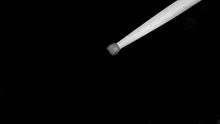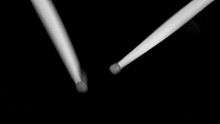Drum rudiment
In percussion music, a rudiment is one of a number of relatively small patterns which form the foundation for more extended and complex drum patterns. The term "rudiment" in this context means not only "basic", but also fundamental. While any level of drumming may, in some sense, be broken down by analysis into a series of component rudiments, the term "drum rudiment" is most closely associated with various forms of field drumming, also known as rudimental drumming.
Rudimental drumming has something of a flexible definition, even within drumming societies devoted to that form of drumming. For example, the longest running website on rudimental drumming defines it as "the study of coordination,"[1] whereas the Percussive Arts Society defines rudimental drumming as a particular method for learning the drums—beginning with rudiments, and gradually building up speed and complexity through practicing those rudiments.[2] (An analogy might be made to learning the piano by first learning scales and arpeggios, as opposed to beginning by taking a full piece of music and grinding through it bit by bit, to the end.)
History
The origin of snare rudiments can be traced back to Swiss mercenaries armed with long polearms. The use of pikes in close formation required a great deal of coordination. The sound of the tabor was used to set the tempo and communicate commands with distinct drumming patterns. These drumming patterns became the basis of the snare drum rudiments.
The first written rudiment goes back to the year 1612 in Basel, Switzerland.[3] The cradle of rudimental drumming is said to be France, where professional drummers became part of the King's honour guard in the 17th and 18th centuries. The craft was perfected during the reign of Napoleon I. Le Rigodon is one of the cornerstones of modern rudimental drumming.[3]
There have been many attempts to formalize a standard list of snare drum rudiments. The National Association of Rudimental Drummers, an organization established to promote rudimental drumming, put forward a list of 13 essential rudiments, and later a second set of 13 to form the original 26. In 1984, the Percussive Arts Society reorganized the first 26 and added another 14 to form the current 40 International Drum Rudiments.[4] Currently, the International Association of Traditional Drummers is working to once again promote the original 26 rudiments.
Today there are four main Rudimental Drumming cultures: Swiss Basler Trommeln, Scottish Pipe Drumming, American Ancient Drumming, and American Modern Drumming.
Terminology
- single stroke
- A stroke performs a single percussive note. There are four basic single strokes.
- double stroke
- A double stroke consists of two single strokes played by the same hand (either RR or LL).
- diddle
- A diddle is a double stroke played at the current prevailing speed of the piece. For example, if a sixteenth-note passage is being played then any diddles in that passage would consist of sixteenth notes.
- paradiddle
- A paradiddle consists of two single strokes followed by a double stroke, i.e., RLRR or LRLL.[5] When multiple paradiddles are played in succession, the first note always alternates between right and left. Therefore, a single paradiddle is often used to switch the "lead hand" in drumming music.
- drag
- A drag is a double stroke played at twice the speed of their context in which they are placed. For example, if a sixteenth-note passage is being played then any drags in that passage would consist of thirty-second notes. Drags can also be played as grace notes. When played as grace notes on timpani, the drag becomes three single (alternating) strokes (rlR or lrL).[6]
- flam
- A flam consists of two single strokes played by alternating hands (RL or LR). The first stroke is a quieter grace note followed by a louder primary stroke on the opposite hand. The two notes are played almost simultaneously, and are intended to sound like a single, broader note.[5] The temporal distance between the grace note and the primary note can vary depending on the style and context of the piece being played.
- roll
- Drum rolls are various techniques employed to produce a sustained, continuous sound.
40 P.A.S. International Drum Rudiments
Rudiments according to the Percussive Arts Society.[5]
Roll rudiments
Single stroke rudiments
The single-stroke roll consists of alternating sticking (i.e., RLRL, etc.) of indeterminate speed and length.
| No. | Name | Notation | Example | Description |
|---|---|---|---|---|
| 1. | Single Stroke Roll |  |
Evenly-spaced notes played with alternating sticking. Though usually played fast, even half notes with alternating sticking would be considered a single stroke roll. | |
| 2. | Single Stroke Four |  |
 Visual/audio example of the drum rudiment single stroke four. |
Four notes played with alternating sticking, usually as a triplet followed by an eighth note. (as in the picture) or as three grace notes before a downbeat (like a ruff). |
| 3. | Single Stroke Seven |  |
Seven notes played with alternating sticking, usually as sextuplet followed by a quarter note. | |
Multiple bounce roll rudiments
| No. | Name | Notation | Example | Description |
|---|---|---|---|---|
| 4. | Multiple Bounce Roll | Alternating handed strokes with no specific number of bounces. Should sound even and continuous. Also called "buzz roll" or "press roll" (most often when referred to in the context of drum-set playing). | ||
| 5. | Triple Stroke Roll |  |
 Visual/audio example of the drum rudiment triple stroke roll. |
Alternating handed strokes with three specific strokes. Each stroke can be bounced or wristed. Also called a "French roll." |
Double stroke open roll rudiments
There are 10 official variants of the double-stroke roll.[5]
| No. | Name | Notation | Example | Description |
|---|---|---|---|---|
| 6. | Double Stroke Open Roll (Long Roll) | Like the single-stroke roll, usually played fast, but even when played slowly, alternating diddles are considered a double stroke roll. Played so each individual note can be heard distinctly. | ||
| 7. | Five Stroke Roll |  |
Two diddles followed by an accented note. | |
| 8. | Six Stroke Roll |  |
 Example of the drum rudiment six stroke roll. |
Unlike most other double stroke rudiments, the six stroke roll begins with an accented single note. Then it is followed by two diddles and another accented note. |
| 9. | Seven Stroke Roll |  |
Three diddles followed by an accented note. Usually a sextuplet followed by a quarter note. | |
| 10. | Nine Stroke Roll |  |
Four diddles followed by an accented note. | |
| 11. | Ten Stroke Roll |  |
Four diddles followed by two accented notes. | |
| 12. | Eleven Stroke Roll |  |
Five diddles followed by an accented note. | |
| 13. | Thirteen Stroke Roll |  |
Six diddles followed by an accented note. | |
| 14. | Fifteen Stroke Roll |  |
Seven diddles followed by an accented note. | |
| 15. | Seventeen Stroke Roll |  |
Eight diddles followed by an accented note. |
Diddle rudiments
| No. | Name | Notation | Example | Description |
|---|---|---|---|---|
| 16. | Single Paradiddle |  |
 Example of the drum rudiment single paradiddle. |
Two alternating notes followed by a diddle. |
| 17. | Double Paradiddle |  |
Four alternating notes followed by a diddle. | |
| 18. | Triple Paradiddle |  |
Six alternating notes followed by a diddle. | |
| 19. | Paradiddle-Diddle |  |
Two alternating taps followed by two alternating diddles. |
Flam rudiments
| No. | Name | Notation | Example | Description |
|---|---|---|---|---|
| 20. | Flam | Two taps (a grace note followed by a full volume tap) played very close together in order to sound like one slightly longer note. In the Hudson Music DVD "Great Hands For a Lifetime", drummer and educator Tommy Igoe describes flams as "the easiest rudiment to play wrong" and goes on to say "...think of the syllable 'lam'. It's one syllable. 'Flam' is still only one syllable, but it's slightly longer." This is a good way for a beginner to conceptualize a "correct" flam. | ||
| 21. | Flam Accent |  |
Alternating groups of three notes of the form [Flam – tap – tap]. | |
| 22. | Flam Tap |  |
Alternating diddles with flams on the first note of each diddle. | |
| 23. | Flamacue |  |
A group of four notes and an ending downbeat, where the first note and the down beat are flammed, and the second note is accented. | |
| 24. | Flam Paradiddle |  |
A paradiddle with a flam on the first note.[5] Also known as a flamadiddle. | |
| 25. | Single Flammed Mill |  |
An inverted paradiddle (RRLR, LLRL) with a flam on the first note of each diddle. | |
| 26. | Flam Paradiddle-diddle |  |
Alternating paradiddle-diddles with flams on the first note of each. | |
| 27. | Pataflafla |  |
 Example of the drum rudiment pataflafla. |
A four-note pattern with flams on the first and last notes.[5] |
| 28. | Swiss Army Triplet |  |
A right hand flam followed by a right tap and a left tap, or (using a left hand lead) a left hand flam followed by a left tap and a right tap.[5][7] It is often used in the place of a flam accent, since repeated flam accents will have three taps on the same hand in a row, where repeated Swiss army triplets only involve two taps on the same hand. | |
| 29. | Inverted Flam Tap |  |
Alternating diddles (offset by one sixteenth note) with a flam on the second note of each diddle. Also known as a tap flam. | |
| 30. | Flam Drag |  |
 Example of the drum rudiment flam drag. |
Alternating groups of three notes of the form [flam – drag – tap]. |
Drag rudiments
| No. | Name | Notation | Description |
|---|---|---|---|
| 31. | Drag (Half Drag or Ruff) | Two diddled grace notes before a tap, which is usually accented. | |
| 32. | Single Drag Tap (Single Drag) |  |
A single drag tap is two alternating notes where the first note has drag grace notes and the second is accented. |
| 33. | Double Drag Tap (Double Drag) |  |
A double drag tap is a single drag tap with another grace note drag before it. |
| 34. | Lesson 25 (Two and Three) |  |
A lesson 25 is three alternating notes where the first note has drag grace notes and the third is accented. |
| 35. | Single Dragadiddle |  |
A single dragadiddle is a paradiddle where the first note is a drag. |
| 36. | Drag Paradiddle No. 1 |  |
The first drag paradiddle is an accented note followed by a paradiddle with drag grace notes on the first note. |
| 37. | Drag Paradiddle No. 2 |  |
The second drag paradiddle is two accented notes followed by a paradiddle, with drag grace notes on the second accented note and the first note of the paradiddle. |
| 38. | Single Ratamacue |  |
A single ratamacue consists of four notes where the first note has drag grace notes and the fourth is accented.[5] |
| 39. | Double Ratamacue |  |
A double ratamacue consists of a single ratamacue with a drag before it. |
| 40. | Triple Ratamacue |  |
A triple ratamacue consists of a single ratamacue with two drags before it. |
Historical organization (Standard 26 American Drum Rudiments)
Thirteen "essential" rudiments
- The Double Stroke Open Roll
- The Five Stroke Roll
- The Seven Stroke Roll
- The Flam
- The Flam Accent
- The Flam Paradiddle
- The Flamacue
- The Drag (Half Drag or Ruff)
- The Single Drag Tap
- The Double Drag Tap
- The Double Paradiddle
- The Single Ratamacue
- The Triple Ratamacue
Second thirteen rudiments
- The Single Stroke Roll
- The Nine Stroke Roll
- The Ten Stroke Roll
- The Eleven Stroke Roll
- The Thirteen Stroke Roll
- The Fifteen Stroke Roll
- The Flam Tap
- The Single Paradiddle
- The Drag Paradiddle No. 1
- The Drag Paradiddle No. 2
- The Flam Paradiddle-diddle
- The Lesson 25
- The Double Ratamacue
Last fourteen rudiments
More recently, the Percussive Arts Society added 14 more rudiments to extend the list to the current 40 International Drum Rudiments. Note that the ordering was completely changed during this last re-organization, so these numbers won't match those above.
- The Single Stroke Four
- The Single Stroke Seven
- The Multiple Bounce Roll
- The Triple Stroke Roll
- The Six Stroke Roll
- The Seventeen Stroke Roll
- The Triple Paradiddle
- The Single Paradiddle-Diddle
- The Single Flammed Mill
- The Pataflafla
- The Swiss Army Triplet
- The Inverted Flam Tap
- The Flam Drag
- The Single Dragadiddle
Notable contributors
- John S. Pratt: author, composer, arranger, Former U.S. Military Academy instructor, Founder of the International Association of Traditional Drummers (IATD)
- Charley Wilcoxon: instructor, author, and teacher
- Dante Agostini, French instructor, author and teacher
- Dr. Fritz R. Berger, inventor of the Berger-Notation, Basel, Switzerland
- J. Burns Moore: instructor, author, and teacher
- Sanford A. Moeller: rudimental champion, author, teacher, drum builder
- George Lawrence Stone: instructor, author, and teacher
- Earl Sturtze: instructor, author, and teacher
- Les Parks: instructor and arranger, Sons of Liberty Fife and Drum Corps, Hawthorne Cabaleros, Garfield Cadets
- Fred Sanford: instructor and arranger, Santa Clara Vanguard Drum and Bugle Corps
- Ralph Hardimon: instructor and arranger, Santa Clara Vanguard Drum and Bugle Corps
- Marty Hurley: instructor and arranger, Phantom Regiment Drum and Bugle Corps during the 1970s and early '80s
- Paul Rennick: instructor and arranger, Phantom Regiment Drum and Bugle Corps: 2003–2010, Santa Clara Vanguard 2011
- Scott Johnson: instructor and arranger, Blue Devils Drum and Bugle Corps
- James Campbell: instructor and arranger, The Cavaliers Drum and Bugle Corps
- Dennis DeLucia: instructor and arranger, Bridgemen Drum and Bugle Corps
- Thom Hannum: instructor and arranger, Cadets Drum and Bugle Corps
- Charley Poole, Jr. instructor and arranger, 27th Lancers Drum and Bugle Corps
- Frank Arsenault: contributor to the selection of the standard 26 rudiments, and a nationwide American teacher known for his official recording of The 26 Standard American Drum Rudiments and Selected Solos
- William F. Ludwig: organizer of and contributor to the selection of the standard 26 rudiments, owner of Ludwig Drum Company
Hybrid rudiments
Over the years, many other rudimental patterns have been informally identified and given creative names, although most of these are based upon the original 40. They are commonly known as "hybrid rudiments" or "hybrids," and are especially common in drumlines and drum corps. A few notable examples are the Herta which is a drag played with alternating sticking (famous examples include the chorus fills by Dave Grohl in "No One Knows" by Queens Of The Stone Age, or the intro by Carter Beauford in "Drive In Drive Out" by The Dave Matthews Band), the Cheese, a diddle with a grace note, and the Eggbeater, a five-tuplet with the sticking "rrrll"; indeed, these hybrids have themselves given way to more innovative and arguably more difficult hybrids, "Cheese Invert" (an inverted flam tap with cheeses instead of flams) and the "Diddle-Egg-Five" (a paradiddle-diddle followed by an Eggbeater and two diddles, one on each hand). Hybrid rudiments are becoming increasingly important to a marching percussionist's rudimental vocabulary. Due to the differences in naming and origins of these numerous hybrid rudiments, a growing list of the most common can be found at the Hybrid Rudiment Library.[8] Also one of the largest lists online can be found at http://www.ninjadrummist.com/drum-rudiments/hybrid-rudiments
In popular culture
A snare/cowbell paradiddle is featured on Skid Row's song "Monkey Business" (at the 2:55 mark). Aerosmith's "Walk this Way" features ride cymbal bell fills that are reminiscent of paradiddles. Buddy Holly's hit "Peggy Sue" features paradiddles all the way through. The dance in "Gangnam Style" is a paradiddle. The song "Vasoline" performed by drummer Eric Kretz of Stone Temple Pilots is another example of a song's drum groove that is strongly based from a single paradiddle. Paradiddles can and are often utilized in drum fills just as with drum grooves. An example of this can be found in Dire Strait's song "Sultans of Swing", around the three quarter mark of the song's completion. Pop singer Meghan Trainor makes reference to different rudiments in the lyrics to her song "Bang Dem Sticks" such as paradiddles, triplets and double strokes.
See also
References
- ↑ "Rudimental Drumming". rudimentaldrumming.com.
- ↑ http://www.pas.org/learn/Rudiments.aspx
- 1 2 http://www.pfyffersyte.ch/files/repertoire/hit2005_PundT.php
- ↑ "History". Percussive Arts Society. Retrieved 23 May 2014.
- 1 2 3 4 5 6 7 8 Percussive Arts Society. "Rudiments Online". Retrieved 15 March 2011.
- ↑ Nasatir, Cary. "Too Many Rudiments?". Conn-Selmer Keynotes. Retrieved 3 February 2008.
- ↑ Swiss Army Triplet Example on VicFirth.com Accessed 8 November 2007.
- ↑ "Vic Firth Presents the Hybrid Rudiments". vicfirth.com.
External links
- 13 essential rudiments rundown sheet from N.A.R.D.
- DrumRudiments.com- All 40 Drum Rudiments with Video examples.
- RudimentalDrumming.com
- Drumline Chops: An Educational Website for Rudimental Drumming and Marching Percussion
- German Site for Drum Rudiments- Videos included.